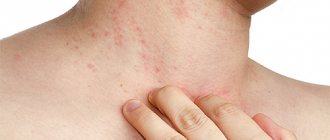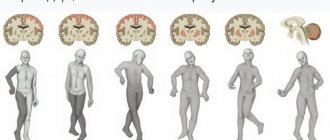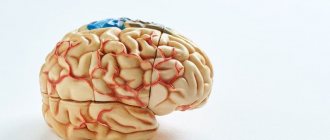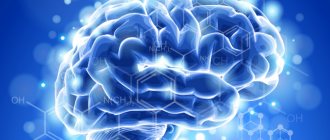How to deal with body pain after stress
Stress causes irreparable damage to the health of every person.
In this case, the body responds to negative emotions and excess tension based on nervousness. In addition to this is muscle pain (myalgia) throughout the body. According to experts, this is a completely natural reaction to external physical and psychological stimuli. These problems can and should be dealt with.
If the disease is not treated in time and proper prevention is not followed, the progression of coronary heart disease or heart attack is high. Does your body hurt from stress?
Body pain due to stress is called myalgia
Causes of pain after stress
Before confronting stress, you need to find out what was the real cause of the disease. Doctors explain that stress matures in tandem with hormones released in huge volumes - adrenaline and norepinephrine. They can provoke high blood pressure.
This leads to damage to the walls of blood vessels and their spasm. Severe pain after experiencing a stressful situation is a natural continuation of the disease, which can contribute to the progression of angina pectoris, hypertension, etc. Stress will not ignore the vital organs of a person.
For women, this is fraught with severe pain attacks during the menstrual cycle.
What are the dangers of stress for the human body?
Stress is formed on a nervous basis. Pain is just a reaction of the muscles and the body as a whole to previously suffered dangers and shocks.
Each person feels it in his own way: a healthy person experiences slight discomfort in the body, a sick person may develop serious problems that can complicate his health.
To prevent a stressful situation, and so that your back, legs, arms and other parts of the body do not hurt in the future, you need to:
- If it is possible to experience a stressful state and accompanying pain, you need to have sedatives with you. These drugs can quickly bring a person’s condition back to normal in conflict and extreme situations.
- Due attention must be paid to the inner mood. If there is a strong desire, everyone can teach themselves and their body to react with restraint to various situations that arise due to nervousness.
- Distract your mind as quickly as possible with other important life situations.
Main features
Myalgia is accompanied by dull and aching muscle pain. A person feels discomfort because... all body movements are constrained. In some cases, anemia may occur. The pain can be distributed throughout the body or in specific points of the head, back, legs, arms.
An increase in these symptoms is often observed during nervous and physical overload, and during stress. After the doctor detects the disease, based on the patient’s stated facts, he will make a diagnosis and prescribe comprehensive treatment.
In this case it is necessary:
- remove the inflammatory focus;
- remove spasm in aching muscles;
- improve blood circulation;
- replenish blood supply to muscle tissue;
- restore the body's metabolic processes.
Numbness of body parts after a stressful situation
Numbness is a painful, uncomfortable tingling sensation, which is accompanied by a decrease in skin sensitivity, and less commonly, a disruption of the normal functioning of the joints of the fingers of the right or left foot or hands.
Parts of the body become numb because a nerve is compressed or the blood supply to tissues is disrupted. Sometimes this ailment is a key sign of diseases of the nervous system. Loss of sensation in some parts of the body may indicate serious illnesses, such as a stroke.
It is necessary to seek the help of a doctor if body parts are removed and:
- no ability to move your toes or hands normally;
- feeling weak, dizzy;
- the bladder empties involuntarily;
- partially or completely unable to speak clearly or move adequately.
Numbness often affects a person’s limbs
Treatment and prevention
If you have pain in the muscles of your back, chest, arms, legs, then you can soothe and warm them up with a heating pad, a warm bath, a heated grain pillow, a compress, or a warming ointment. It is necessary to carry out these measures, because The thermal effect is designed to improve blood circulation at the site of pain, increase the body's energy supply, and help to quickly restore the affected muscles.
Myalgia often forms in the thoracic region, occipital region, and shoulder girdle. To avoid pain in these areas due to stress, you should follow a number of preventive measures:
- keep your posture as straight as possible, align your neck muscles, walk as often as possible;
- perform light physical exercises to stretch and relax the muscles of these parts of the body.
You can relieve pain in the affected area that occurs due to stress by using magnesium, potassium and calcium. Homeopathic remedies are the best way to help. When choosing a drug, you must strictly follow the instructions.
Homeopathy is effective for myalgia
If you still cannot cope with constant pain on your own, you must seek the help of a qualified doctor. After a thorough examination, a professional will discover the sources and causes of the disease.
In almost all cases of myalgia, experts advise using Diclofenac (a non-steroidal anti-inflammatory drug), which relieves pain. This drug is produced in the form of ointments, injections, and tablets. The course of treatment takes 10 days.
During the first days, you need to carefully monitor your skin to avoid side effects.
You can get rid of the aching pain with the help of a course of massage and therapeutic exercises. Acupressure helps eliminate muscle tone and stiffness, helps blood circulation, and saturates muscle tissue with the necessary amount of oxygen.
Despite the physical pain, to prevent the nervous system it is necessary to visit a psychologist several times a week. During the treatment process, you should adhere to proper sleep patterns, nutrition, drink plenty of water, and do hour-long walks.
Neglected, untreated muscle pain causes irreparable damage to the spine. In this case, the intervertebral discs wear out, which is fraught with the formation of the most dangerous complications: hernia, protrusion, osteochondrosis.
You can achieve the maximum result of fully relieving muscle pain from stress by identifying the cause in time and performing high-quality professional treatment aimed at removing tension in the muscles.
Source: https://urazuma.ru/stress/bolit-telo.html
Main features
Myalgia is accompanied by dull and aching muscle pain. A person feels discomfort because... all body movements are constrained. In some cases, anemia may occur. The pain can be distributed throughout the body or in specific points of the head, back, legs, arms. An increase in these symptoms is often observed during nervous and physical overload, during stress. After the doctor detects the disease, based on the patient’s stated facts, he will make a diagnosis and prescribe comprehensive treatment. In this case it is necessary:
- remove the inflammatory focus;
- remove spasm in aching muscles;
- improve blood circulation;
- replenish blood supply to muscle tissue;
- restore the body's metabolic processes.
Neurological pain
The most common disease of the peripheral nervous system leading to neck pain is cervical radiculitis
.
The basis of this pathology is damage and infringement of the roots of the spinal nerves of the cervical spine.
Causes
The most common cause of cervical radiculitis is degenerative diseases of the spine (osteochondrosis and spondyloarthrosis), in which bone growths at the junction of the vertebrae reduce the lumen of the holes between them and compress the passing roots of the spinal nerves, causing pain.
The cause may also be inflammation of the muscles and ligaments located near the nerve and pressing on its root.
Cervical radiculitis can also occur as a result of injury, hypothermia, intoxication, or as a complication of an infectious disease.
In some cases, the disease is a consequence of a herniated disc in the cervical spine.
Manifestations
The disease is characterized by neck pain. As a rule, it appears suddenly, is sharp and intense. The pain can be dull and aching, but movements that increase irritation of the roots (tilting and turning the head, sneezing and coughing) significantly intensify the pain, which becomes sharp and cutting.
“Shooting” pains spread to the muscles and fingers, “radiating” to the back of the head, shoulder, and shoulder blade. It is often difficult to find a comfortable sleeping position; at night a person wakes up due to “stabbing” pain in the arms and neck.
In severe cases, sensations of numbness, tingling, and burning occur in the skin of the hand, sensitivity is lost, muscle strength may significantly decrease, and muscle atrophy may gradually occur.
Principles of treatment
Cervical radiculitis should be treated by a doctor. It is aimed mainly at eliminating the causes that caused radiculitis. Success largely depends on the timely start of treatment, and recovery is possible only with persistent comprehensive treatment.
When treating cervical radiculitis, it is recommended to reduce the load on the cervical vertebrae and temporarily limit tilting and turning the head to relieve irritation of the spinal nerve roots. A neck brace can help in severe cases.
During the acute course of the disease, painkillers and anti-inflammatory drugs, including topical ones, are effective as symptomatic therapy.
The best remedy when the pain subsides is a light massage of the cervical-collar area.
After the pain disappears, physical therapy exercises are recommended.
Physiotherapeutic treatment and thermal procedures are also used.
Back
Neurological back pain is widespread among all age groups of the population and is one of the reasons for the increase in morbidity with temporary disability. Almost 90% of people have experienced back pain at least once in their lives.
The main diseases leading to back pain are thoracic radiculitis and lumbosacral radiculitis
.
Limbs
The occurrence of neurological pain in the extremities is caused by damage to large and medium peripheral nerves. If the process is inflammatory in nature, it is neuritis
, and in case of a toxic, ischemic or degenerative process -
neuropathy
.
Stress and appearance
There is an opinion that a person’s posture may change due to exposure to strong stress, which manifests the work of the body’s defense mechanisms.
In the event of a nervous breakdown, muscle contraction occurs in the neck and lower back, and the musculoskeletal system may also be affected due to nervousness.
Due to back pain after stress, scoliosis forms. Scoliosis is the most famous form of curvature, in which the joints of the spine are deformed.
Why is scoliosis dangerous?
Body pain due to neuroses, depression and VSD: can legs, back joints hurt?
Neurosis is a complex of psychogenic diseases characterized by both mental and physical symptoms.
Statistics from studies on neuroses are quite varied and the results change every year, but the trend towards an increase in the number of people suffering from neuroses continues from year to year.
According to the latest WHO research, the number of people suffering from neurosis has increased 25 times over the past 70 years. And all this despite the fact that only patients who sought help from medical institutions are included in the statistics.
Experts say that since the beginning of the 20th century, the number of patients with neurosis has increased at least 30 times. Today, neurosis is the most common mental illness.
Signs of neurosis can be both mental and physical, manifesting themselves in the form of inadequate reactions, behavioral disorders, various pain sensations, etc. Health disorders occur that impede a person’s interaction with society.
All reality is perceived distorted by a patient with neurosis, performance decreases, life goals and values disappear, and at the same time constant painful sensations bother him. Pain in the heart, stomach, muscle and joint pain, and others are often observed with neurosis.
And although neurosis is a disease with many faces, so to speak, there are still its typical symptoms. Let's take a closer look at them.
Symptoms of neurosis can be physical - for example, back pain
The main signs of neurosis
The main difference between neurosis and other mental illnesses is the fact that the patient realizes that he is not healthy and his consciousness is not impaired. The condition of a person suffering from neurosis is not burdened by delusions or hallucinations, and reality is perceived adequately by him.
Neurosis affects various systems of the body, primarily its psyche, which can be reflected in the form of psycho-emotional disorders.
Neurosis and its mental symptoms:
- Emotional stress;
- A peculiar response to stress (closedness, isolation, fixation);
- Memory impairment;
- Increased sensitivity (irritability in bright light, loud sounds);
- Frequent, causeless mood swings;
- Apathy and loss of interest in life.
The physical symptoms of neurosis are very diverse and are in turn divided into vegetative and physical. Disorders that arise in parts of the body associated with the autonomic system are functional and do not have an organic origin. That is, the patient complains of pain and feels certain disorders in a part of the body, but no specific pathological abnormalities are found in him.
Neurosis and its vegetative symptoms:
- Vasomotor syndrome (headaches, dizziness, blood pressure surges);
- Vegetative-skin syndrome (itching, rash, redness or pallor of the skin);
- Visceral syndrome (difficulty breathing, problems with swallowing, frequent urination, abnormal stool);
- Vegetative-trophic syndrome (trophic ulcers, muscle atrophy);
- Allergic syndrome (swelling, rash, itching, etc.).
Worth seeing: Symptoms and treatment of neurosis in adults
Neurosis is often combined with a disease such as vegetative-vascular dystonia or VSD. In addition to headaches and heart pain, muscle and joint pain are considered quite common with VSD.
Headache is a vegetative sign of neurosis
Neurosis and its physical (bodily) signs
Pain and other various unpleasant sensations in certain parts of the body are also a sign of neurosis. Moreover, if with an organic disease of the nervous system the pain has a clear localization, then with neurosis the pain can move from one part of the body to another, and its severity will directly depend on the psycho-emotional state of the person.
Most often, people suffering from neurosis experience a headache. According to statistics, in more than 50% of cases, neurosis is accompanied by a headache.
And this is not surprising, because neurosis is a disease of the nervous system and it is the brain that suffers.
But in the modern world, neurosis has increasingly begun to cause pain in those parts of the body that, at first glance, are not directly related to the activity of the brain. Let's consider several variants of the manifestation of neurosis that are not so common.
Pain due to neurosis in the back and legs
Pain due to neurosis is noted in the back and legs, which in turn at first glance is very similar to lumbosacral radiculitis.
However, a distinctive feature of pain in neurosis will be the lack of clear localization.
If the local painful point is in the leg, then in addition to pain, some tingling, numbness or a pins and needles sensation may be felt. There is a decrease or, conversely, a clear increase in sensitivity.
Back pain due to neurosis can appear with the slightest injury to the spine and last for quite a long time. In addition, due to strong suggestibility, a person suffering from neurosis may experience pain in the back and legs even without any external influences. For example, after talking with a patient with radiculitis, he “discovers” exactly the same signs of the disease.
Legs with neurosis can get sick even without injuries or other influences
Muscle pain due to neurosis
Muscle pain can be psychogenic in nature. Such pains do not have a clear localization and obvious causes.
They are characterized by obvious exacerbations during stress, anxiety, muscle pain increases and during depression.
As soon as the stressful effect ends and a period of rest begins, the pain subsides, but with the slightest overload of the nervous system, it returns again, manifesting itself with even greater force.
Very often, neurosis also manifests itself in muscle pain, occurring with severe physical fatigue, as well as with the monotony of work performed. This type of neurosis can also be provoked by a sedentary lifestyle and severe emotional overload.
For neurosis manifested by muscle pain, complex treatment is used - this includes medications, psychotherapy and therapeutic exercises, it is possible to use individual diets and adjustments to the daily routine, and sometimes physiotherapy is included.
It should be remembered that with neurosis, as with any other disease, timely diagnosis and prescription of an individual course of treatment are very important. But as everyone knows, it is easier to prevent the occurrence of a particular disease than to cure it. To do this, let us consider in more detail the causes of neuroses.
Worth seeing: Chills in neurosis
Causes of neurosis
The main cause of neurosis is a psychotraumatic factor or a psychotraumatic situation. In the first case, the negative impact is short-term, for example, the loss of a loved one. In the second - long-term, for example, family conflict. The main role in the occurrence of neurosis is played by traumatic situations, most often intra-family conflicts.
The inability to productively resolve a conflict to one degree or another can lead to personality disorganization, which in turn manifests itself in mental and physical symptoms.
Psychotraumatic factors and situations include:
Family and household conflicts are a common cause of neuroses
Family and household conflicts.
- Cheating and separation;
- Frequent conflicts, scandals;
- Excessive strictness in education or vice versa – pampering;
- Pathological jealousy;
- Pronounced suppression and leadership;
- Ambition of parents.
Interpersonal conflicts.
They can occur between family members or be non-family (for example, at work). In interpersonal conflict, the needs of two people contradict, disorganizing mental activity and leading to constant tension. It is these conflicts that in 35% of cases lead to the obvious development of neurosis.
Intrapersonal conflicts.
In this conflict, a person’s desires, his own needs and emotions contradict. With this conflict, when desires do not coincide with possibilities, psycho-emotional distress is generated, which underlies neurosis. Intrapersonal conflicts lead to the development of neuroses in men, namely in 45% of cases.
Derived factors.
A variety of unfavorable factors at work can be a source of development of serious neurosis. Conflicts with colleagues and management, lack of career advancement, low pay - all of this can be attributed to derived factors.
The death of a loved one is very traumatizing to the psyche.
Death of a loved one.
The loss of a dear, close person is a powerful psycho-traumatic factor. However, this factor does not lead a person to a neurotic state, but only aggravates hidden conflicts.
Source: https://psycholekar.ru/nevroz/simptomyi/boli-pri-nevrozah.html
Preventive actions
Very often, pain in the muscles of the neck, chest, back, arms and pain in the legs appears due to stress. Recommended preventive measures:
- If a person has a sedentary job, it is necessary to do a warm-up.
- Maintain correct posture.
- Do exercises and stretching exercises every morning.
If a person suffers from severe muscle pain due to stress, then treatment needs to be started. To relieve pain syndromes, you can use ointments, injections or tablets, but it is better to first consult a doctor.
When stressed, it hurts: back, legs, body, muscles, what to do
Stressful situations at work and troubles in your personal life negatively affect your condition. A person feels pain stress. Aching pain in the joints creates nervous tension. You may feel like your left arm is numb, a feeling of heaviness in the abdomen, or your legs hurt. Often, under stress, it is difficult to determine the source of pain; it may seem that the whole body hurts.
Stress pain can occur in different parts of the body
Nervous shocks can be caused by various reasons: accident, death, injury. This type of stress changes a person's lifestyle.
Another type of stress, prolonged, appears as a result of prolonged exposure to unfavorable factors. This phenomenon also occurs due to low blood circulation and metabolic disorders in the body.
Prolonged stress often appears due to drinking, smoking, poor sleep, and poor work.
Symptoms
Stress is the body's reaction to negative emotions and tension. When you are stressed, your whole body hurts. The pain can be of different types: aching and dull, and can manifest itself in the neck and spine.
Due to physical stress, pain may increase. When the doctor determines the causes of the disease, he will prescribe a comprehensive treatment that will lead to:
- eliminating inflammation;
- improving blood circulation;
- filling muscle tissue with blood circulation;
- restoration of the body's metabolic systems.
Joint pain
The most popular joint disease caused by stress is osteochondrosis. It manifests itself from increased pressure on nerve cells in the area of joint tissue. As a result, pain appears and blood circulation is disrupted. Joints may hurt due to arthritis and rheumatism.
Stages of osteochondrosis
Stress and appearance
There is an opinion that a person’s posture may change due to exposure to strong stress, which manifests the work of the body’s defense mechanisms.
In the event of a nervous breakdown, muscle contraction occurs in the neck and lower back, and the musculoskeletal system may also be affected due to nervousness.
Due to back pain after stress, scoliosis forms. Scoliosis is the most famous form of curvature, in which the joints of the spine are deformed.
Why is scoliosis dangerous?
Treatment methods
Consuming magnesium, calcium and potassium will help cope with painful conditions caused by stress. Homeopathic medicines have proven themselves well.
When using the medicine, you must follow the instructions for use. If the pain occurs frequently, you need to go to the hospital. The doctor must conduct an examination, understand the causes and prescribe treatment.
Diclofenac perfectly relieves severe pain. It can be bought at the pharmacy in the form of ointments, tablets or injections.
Diclofenac is a non-steroidal drug that relieves inflammation and treats joints and muscles well. The drug contains components that relieve pain, swelling and inflammation.
You can also use Myoton, which consists of plant components. It relieves pain well and has an antiseptic and anti-inflammatory effect. Course 10 days.
Massage and therapeutic exercises will give an excellent effect. Massage eliminates muscle hypertonicity (right arm hurts), stiffness, improves blood circulation, and also nourishes body tissues with oxygen and frees them from harmful elements.
When the whole body hurts, warming procedures will help:
- bath;
- warm bandages, heating pads;
- warming ointments.
When heat begins to work, blood circulation improves. Finalgon dilates blood vessels and has an anti-inflammatory and warming effect. It is used 2 times a day, applied to the disturbing part of the body.
Loss of skin sensitivity from stress and muscle pain puts a strong strain on the spine, and disc displacement appears. It can cause hernia and osteochondrosis.
Diclofenac relieves pain in joints and muscles
Preventive actions
Very often, pain in the muscles of the neck, chest, back, arms and pain in the legs appears due to stress. Recommended preventive measures:
- If a person has a sedentary job, it is necessary to do a warm-up.
- Maintain correct posture.
- Do exercises and stretching exercises every morning.
Conclusion
If a person suffers from severe muscle pain due to stress, then treatment needs to be started. To relieve pain syndromes, you can use ointments, injections or tablets, but it is better to first consult a doctor.
Source: https://psyhoday.ru/stress/bolit-telo.html
Causes
Why do muscles hurt after stress? People who are under stress experience signs of psychometric disorder. These may be disruptions in the functioning of internal organs, headaches.
When the body is under stress, adrenaline is released, which causes severe anxiety. You can try to calm down on your own: sleep, rest, read your favorite book, communicate with your family. Sedative medications or herbal infusions will help relieve anxiety:
- mint, hops and nettle;
- passionflower, thyme, St. John's wort;
- willow leaves;
- motherwort or valerian.
You can relieve chest pain from nerves with the help of Novopassit, Nervoflux, Persen. Vitamins B1-B12 perfectly relieve tension. They are easy to find at the pharmacy. To restore the strength that was spent fighting stress, vitamins E and C are needed.
What diseases can develop?
Every person sooner or later has this problem: their legs hurt from the knee to the foot. There may be several reasons for this - both completely harmless (fatigue after a hard day at work) and serious diseases of the joints, the treatment of which should not be delayed. Therefore, if leg pain localized below the knee is alarming, you should immediately consult a doctor for further examination.
The causes are mainly divided into two broad categories: pain from overwork that goes away after rest, and pain caused by serious pathologies such as arthritis and venous disease.
In most cases, the legs below the knees hurt on the side, behind or in front due to fatigue, heavy load on the legs after running, or incorrectly selected shoes with high heels in women. In short, such factors can be easily eliminated, and pain can be relieved with the help of painkillers, massage or relaxation.
Another cause of severe pain is sprained muscles and ligaments below the knee joint. Of course, this problem also needs to be eliminated, but it does not pose a potential danger. However, if your legs below the knees hurt for too long, you should not put off visiting a doctor.
The lower leg consists of the tibia and fibula, the knee joint on top and the ankle joint below. The bones are surrounded by muscles, numerous ligaments and nerves. Damage to all of these tissues can cause pain below the knee. In most cases, discomfort occurs due to the process of destruction of the joint or its weakening. There is another serious reason - varicose veins. It could also be nerve pain.
The main causes of discomfort in the legs:
- injuries and damage to muscle tissue from the knee to the foot;
- neurogenic pain (sciatica);
- damage to leg bones, knee joints or foot bones;
- venous thrombosis;
- Arthrosis and arthritis of the joints;
- rupture of the popliteal cyst (Baker's cyst);
- superficial vein thrombosis;
- postthrombophlenic syndrome;
- rheumatism;
- lymphostasis;
- compression of the soft tissues of the leg below the knee and others.
The appearance of pain in the musculoskeletal system develops for various reasons. With neurosis, the most likely disease that can develop is osteochondrosis. It is virtually impossible to determine the root cause of pain in the knees, neck, spine, and elbows. But doctors say that it is quite possible to feel muscle pain due to neurosis. Every 3rd person on the planet with arthrosis gets this disease from exposure to a stress factor.
With depression or psycho-emotional stress, pressure on the roots of nerve fibers in the joint tissues increases. Due to stress, blood circulation is disrupted and the joint begins to hurt. If we are talking about posture, then physiologically a person shrinks when feeling stress. The muscles of the neck and lower back begin to contract characteristically, causing scoliosis.
Nervous immunity decreases, and the risk of infection and development in the body increases. In this way, arthritis may develop. Long-term depression causes increased production of corticosteroid hormones, large amounts of which reduce the concentration of hyaluronic acid. The joints do not receive the necessary lubrication, their elasticity and functionality decrease, friction increases, which provokes inflammatory processes and muscle pain. VSD (vegotovascular dystonia) is characterized by the development of hypertonicity and spasm of the muscles that clamp the joints, causing their deformation.
Nervous stress tends to cause:
- chondrosis,
- osteochondrosis,
- arthrosis,
- arthritis,
- coxarthrosis,
- rheumatism,
- scoliosis.
Joint pain does not occur without a reason. They are harbingers or signals about the development of diseases of the musculoskeletal system. Changes in posture, circulatory disorders, and hormonal imbalances negatively affect overall health. Psychological disruptions provoke frequent headaches, fatigue, aches and tension in the body.
Most specialists involved in the elimination of pain in neurosis say that in the absence of effective therapeutic measures, the pathological condition will not disappear. If the root causes of the disease persist in the form of systematic stress, conflicts with family or work colleagues, the person will constantly experience negative emotions, causing a deterioration in overall well-being.
With neurosis, the production of lubricant in the joint structures sharply decreases, this factor contributes to the drying out of the cartilage. As a result of this pathological process, microcracks and damage appear on them. Excessive amounts of corticosteroids affect the legs, the condition of the capillaries, and lead to a deterioration in the nutrition of cartilage tissue.
- thrombophlebitis;
- atherosclerosis of the legs;
- phlebeurysm.
In depression, adrenaline and norepinephrine negatively affect the bone and joint system and impair blood circulation. Their excess provokes muscle spasms and pain. The sciatic nerve is often pinched by nerves. Arthritis manifests itself as severe, acute pain in the muscles and joints and leg. If the pain is systematic, you should immediately consult a doctor, carry out the necessary diagnostic procedures, and undergo a course of massage therapy.
When the pain intensifies in the evening, you need to consult with an orthopedist and choose the right orthopedic shoes. With arthrosis, damaged joints react strongly to weather changes. Walking for a long time or staying in one position for a long time can cause severe discomfort in the legs.












